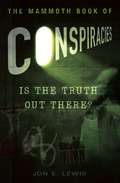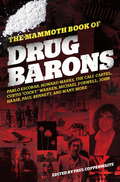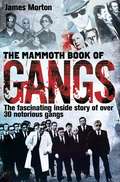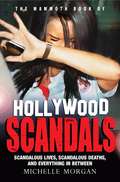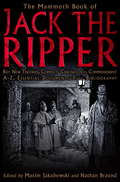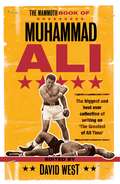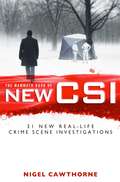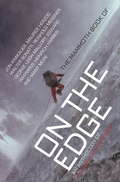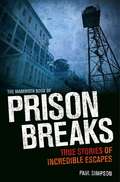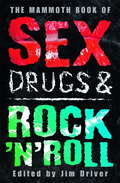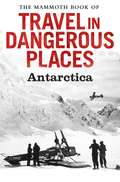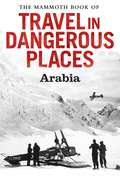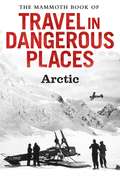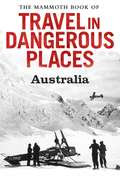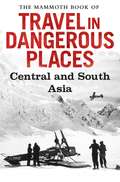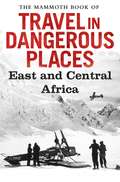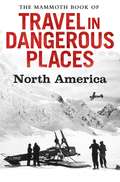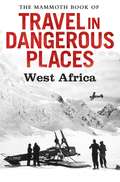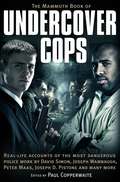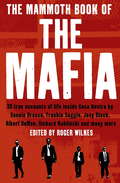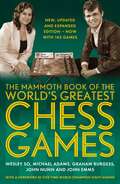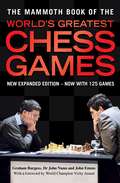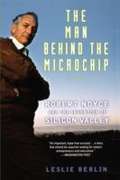- Table View
- List View
The Mammoth Book of Conspiracies (Mammoth Books #369)
by Jon E. LewisBang up to date with fresh cover-ups relating to Barack Obama, Michael Jackson and AfghanistanThe 100 military, medical, religious, alien, intelligence, banking and historical cover-ups 'they' really don't want you to know about: The Military-Industrial Complex's fomentation of war with Iraq; the construction of concentration camps in the United States by FEMA (the Federal Emergency Management Agency); the use of alien 'Foo Fighters' by the Nazis and the Japanese during the Second World War; the miracle natural drug suppressed by Big Pharma; the Israelis' responsibility for the bombing of USS Cole; the real reason why CERN broke down; the murder of Paul McCartney - and you didn't even know he was dead. Entertainingly written and closely documented, The Mammoth Book of Conspiracies uncovers the 100 most secret cover-ups in an accessible A-Z format. It covers 95 new conspiracies even more fiendish than those detailed in The Mammoth Book of Cover-Ups by the same author, and provides fresh revelations regarding the five furthest-reaching conspiracies in that book, including the assassination of JFK and 9/11. The book includes a full bibliography and introduction.
The Mammoth Book of Drug Barons (Mammoth Books #224)
by Paul CopperwaiteThe rise - and fall - of the outlaw lords of the drug world, from the Cali Cartel, the richest, most powerful crime syndicate in history, to Britain's biggest drug baron, Curtis 'Cocky' Warren and the 'Essex Triple Murders'. From freewheeling cannabis operations to the lethal 'heaviness' of organized crime, the doings of the dealers, bouncers, bagmen and 'taxmen' - those crazy enough to extort money from drug dealers - of a ruthlessly violent underworld. Here you will find an account of the pursuit and capture of 'Mr Nice', Howard Marks (along with the complementary recollections of Mrs Marks), the story of the hunt for Pablo Escobar and an in-depth piece on cocaine production deep in the Colombian interior. This is the no-holds-barred, inside story of drug trafficking, from the Golden Triangle to the Golden Gate and from Spain's Costa del Crime to the future of conflict and prohibition with its fresh cast of Afghan warlords and central European gangsters. It examines how and why things go wrong, and the price which is paid when they do.
The Mammoth Book of Gangs (Mammoth Books #407)
by James MortonA fresh, new look at gangs in every part of the world which deliberately avoids the stories that have been done to death - about Capone, Dillinger, Bonnie and Clyde - and focuses on less well-known gangs such as 'Ma' Barker's Boys; the Smaldones of Denver; Scotland Yard's 1960s' Flying Squad, the so-called Firm within a Firm; Dr Death, the Melbourne drug dealer and Andre Stander, the former South African police officer who led a gang of bank robbers before being shot dead in Fort Lauderdale having fled a 17-year sentence.
The Mammoth Book of Hollywood Scandals (Mammoth Bks.)
by Michelle MorganMurders, suicides, unexplained deaths, scandalous romances, illegitimate children, cover-ups, and more, from the 1920s to Hollywood's Golden Age in the 1960s and right up to the present day.It covers over 60 scandals including: The Roscoe 'Fatty' Arbuckle Scandal; Clark Gable's Baby Scandals; The Rape of Patricia Douglas; The Life and Death of Jean Harlow; The Sudden Death of James Dean; Marilyn Monroe's Mysterious Death; John Belushi Dies at the Chateau Marmont; Madonna's Hollywood Stalker; Hugh Grant's Hollywood Scandal; Winona Ryder Is Arrested For Shoplifting; The Brad Pitt, Jennifer Aniston and Angelina Jolie Love Triangle; The Tragic Life and Death of Anna Nicole Smith; The Life and Death of Michael Jackson; Arnold Schwarzenegger's Love Child; The Very Public Melt-Down of Charlie Sheen; The Rise and Fall of Whitney Houston; The Marriage of Tom Cruise and Katie Holmes and many, many more.
The Mammoth Book of Hollywood Scandals (Mammoth Books #406)
by Michelle MorganMurders, suicides, unexplained deaths, scandalous romances, illegitimate children, cover-ups, and more, from the 1920s to Hollywood's Golden Age in the 1960s and right up to the present day.It covers over 60 scandals including: The Roscoe 'Fatty' Arbuckle Scandal; Clark Gable's Baby Scandals; The Rape of Patricia Douglas; The Life and Death of Jean Harlow; The Sudden Death of James Dean; Marilyn Monroe's Mysterious Death; John Belushi Dies at the Chateau Marmont; Madonna's Hollywood Stalker; Hugh Grant's Hollywood Scandal; Winona Ryder Is Arrested For Shoplifting; The Brad Pitt, Jennifer Aniston and Angelina Jolie Love Triangle; The Tragic Life and Death of Anna Nicole Smith; The Life and Death of Michael Jackson; Arnold Schwarzenegger's Love Child; The Very Public Melt-Down of Charlie Sheen; The Rise and Fall of Whitney Houston; The Marriage of Tom Cruise and Katie Holmes and many, many more.
The Mammoth Book of Jack the Ripper (Mammoth Books #310)
by Maxim JakubowskiUpdated and expanded edition of the fullest ever collective investigation into Jack the Ripper and the Whitechapel Murders.This volume collects not just all the key factual evidence but also 20 different arguments as to the identity of Jack the Ripper, such as that advanced by Patricia Cornwell. Contributions are from the world's leading Ripperologists, including William Beadle, Melvyn Fairclough, Martin Fido, Shirley Harrison, James Tully and Colin Wilson. The identity of Jack the Ripper has plagued professional historians, criminologists, writers and amateur enthusiasts. The many suspects include Montague John Druitt, Walter Sickert, Aaron Kosminski, Michael Ostrog, William Henry Bury, Dr Tumblety and James Maybrick. The only certainty is that Ripperologist have not found an invididual on whom they can all agree. The essays are supported by a detailed chronology, extensive bibliography and filmography.
The Mammoth Book of Muhammad Ali (Mammoth Books #472)
by David WestFrom his gold medal at the 1960 Olympic Games to his defeat of Sonny Liston to claim the world heavyweight championship in 1964, the unforgettable 'Thrilla in Manila' against Joe Frazier and the 'Rumble in the Jungle' against George Foreman, 'The Greatest of All Time', Muhammad Ali, has captured the attention of the world. His conversion to Islam, his refusal to serve in the in the Vietnam War ('I ain't got no quarrel with them Vietcong') and his speaking tours in the 1960s have all contributed to his status as one of the most revered sporting figures ever. Here, drawn from books, specialist periodicals, newspapers, college magazines (covering his speaking tours) and the work of major literary figures such as Thomas Hauser is the biggest and best collection ever of writing on 'The Greatest'.
The Mammoth Book of New CSI: Forensic science in over thirty real-life crime scene investigations (Mammoth Books #218)
by Nigel CawthorneDetailed accounts of over 30 contemporary cases, or older cases reopened as a result of advances in forensic science. Crime scene investigations draw on a wide range of cutting-edge technology including genetic fingerprinting, blood splatter analysis, laser ablation, toxicology and ballistics analysis. Cases covered here include: the abduction of Madeleine McCann; the vindication of Colin Stagg, convicted of having murdered Rachel Nickell; Hadden Clark who killed and ate a six-year-old child in Maryland; Robert Pickton, the Vancouver farmer who fed his female victims to his pigs; the murder of Meredith Kercher in Perugia (was Amanda Knox guilty?); Lindsay Hawker's gruesome death in Japan; Josef Fritzl and the cellar in which he imprisoned and raped his daughter.
The Mammoth Book of On The Edge (Mammoth Books #383)
by Jon E. LewisNo one sees clearer than an individual whose life is hanging by the finger tips on the edge of an abyss. Probing the furthest reaches of human daring and endurance, here are 28 of the great first-hand accounts of extreme mountaineering, from legendary names. Written by the bestselling author of Meadowland and The Running Hare, Featuring:·Heinrich Harrer - first conqueror of the notorious Eigerwand.·Robert Bates - the classic account of the ill-fated American 1953 expedition to K2.·Maurice Herzog - his unstoppable ascent of Annapurna at the cost of frostbite.·Walter Bonatti - tragedy on the Central Pillar of Freney on Mont Blanc.·George Leigh Mallory - surviving an avalanche on the 1922 Everest expedition.·René Desmaison - his epic story of 14 days stuck on The Grandes Jorasses in winter.·Jon Krakauer - recalling his solo ascent of The Devil's Thumb in Alaska.The price of the summit is often measured in human suffering, yet for those who succeed the rewards can be incalculable. Nerve-wracking and unputdownable.
The Mammoth Book of Prison Breaks (Mammoth Books #430)
by Paul SimpsonTrue stories of prison breaks including those of Frank Abagnale, whose story is told in Catch Me If You Can; Henri Charrière who claimed to have escaped from the supposedly inescapable Devil's Island - the true story as opposed to his questionable memoir, Papillon; Bud Day, said to be the only US serviceman ever to have escaped to South Vietnam; the six prisoners who escaped from Death Row in Mecklenburg Correctional Center; and Pascal Payeret, the French armed robber who escaped not once, but twice from French prisons with the help of a helicopter.
The Mammoth Book of Sex, Drugs & Rock 'n' Roll (Mammoth Books #249)
by Jim DriverOver 60 gripping accounts tracking the dark side of rock 'n' roll from the early days of the drugs-and-drink culture, and the birth of rock 'n' roll, through The Beatles, Stones, Sex Pistols, Madonna, Kurt Cobain and Oasis, to Amy Winehouse, Pete Doherty and other stars of the current rock-music scene.From trashed hotel rooms to cars in swimming pools, all rock 'n' roll's excesses are here, including murder and sexual deviancy, surprising brushes with the law that the stars thought they'd kept quiet, early and tragic deaths, drug overdoses, robbery, mis-marriages and groupies by the truckload
The Mammoth Book of Travel in Dangerous Places: Antarctic (Mammoth Books #345)
by John KeayFarthest South - Ernest Henry ShackletonBorn in Ireland, Shackleton joined the merchant navy before being recruited for Captain Scott's 1901 expedition to Antarctica. He was with Scott on his first attempt to reach the South Pole and, though badly shaken by the experience, realized that success was now feasible. In 1907, with a devoted team but little official support, he launched his own expedition. A scientific programme gave it respectability but Shackleton was essentially an adventurer, beguiled alike by the challenge of the unknown and the reward of celebrity. His goal was the Pole, 90 degrees south, and by Christmas 1908 his four-man team were already at 85 degrees.The Pole at Last - Roald AmundsenAmundsen's 1903-6 voyage through North West Passage had heralded a new era in exploration. The route by then was tolerably well known and its environs explored. His vessel was a diminutive fishing smack, his crew a group of Norwegian friends, and his object simply to be the first to have sailed through. He did it because it had not been done and "because it was there". The same applied to his 1911 conquest of the South Pole. Shackleton had shown the way and Amundsen drew the right conclusions. The Pole was not a scientist's playground nor a mystic's dreamland; it was simply a physical challenge. Instead of officers, gentlemen and scientists, he took men who could ski and dogs that could pull; if need be, the former could eat the latter. The only real anxiety was whether they would forestall Scott.In Extremis - Robert Falcon ScottScott was chosen to lead the 1900-4 British National Antarctic Expedition. Its considerable achievements seemed to vindicate the choice of a naval officer more noted for integrity and courage than any polar experience, and, following Shackleton's near success, in 1910 Scott again sailed south intending to combine a busy scientific programme with a successful bid for the South Pole. On 17 January 1912 he and four others duly reached the Pole, indeed they sighted a real pole and it bore a Norwegian flag; Amundsen had got there 34 days ahead of them. Bitterly disappointed, soon overtaken by scurvy and bad weather, and still dragging sledges laden with geological specimens, they trudged back. The tragedy which then unfolded eclipsed even Amundsen's achievement and won them an immortality beyond the dreams of any explorer.
The Mammoth Book of Travel in Dangerous Places: Arabia (Mammoth Books #346)
by John KeayEscape from Riyadh - William Gifford PalgraveA scholar and a solider, a Jesuit and a Jew, a French spy and a British ambassador- Palgrave was a man of contradictions, all of them highly compromised when in 1862-3, fortified by Pius IX's blessing and Napoleon III's cash, he attempted the first west- east crossing of the Arabian peninsular. To steely nerves and a genius for disguise he owed his eventual success; but not before both were sorely tested when, as a Syrian doctor, he became the first European to enter Riyadh. The desert capital of the fanatical Wahabis, dangerous for an infidel at the best of times, was then doubly so as the sons of the ageing King Feisal intrigued for power.Desert Days - Charles Montagu DoughtyDuring two years (1875-7) wandering in Central Arabia Doughty broke little new ground; dependant on desert charity, his achievement was simply to have survived. Yet his book, Arabia Deserta, was instantly recognized as a classic. Its eccentric prose proves well suited to that minute observation and experience of Bedouin life which was Doughty's main contribution to exploration. T.E. Lawrence called it "a bible of a kind"; both syntax and subject matter have biblical resonances, as in this description of a day's march, or rahla.
The Mammoth Book of Travel in Dangerous Places: Arctic (Mammoth Books #347)
by John KeayFour Years in the Ice - John RossDisgraced and dishonored for his report of an imaginary mountain range blocking the most likely access to the North West Passage, in 1829 Ross returned to Canada's frozen archipelago to vindicate his reputation. He rounded the north of Baffin Island and entered what he named the Gulf of Boothia. Here the Victory, his eccentric paddle-steamer, became frozen to the ice. Through three tantalizingly brief summers the expedition tried to find a way out and through four long winters then endured the worst of Arctic conditions in a makeshift camp. In July 1832, with the ship long since abandoned, Ross made what must be their last bid to reach open water.Living off Lichen and Leather - John FranklinIn 1845, looking again for the North West Passage, two well-crewed ships under Franklin's command sailed into the Canadian Arctic and were never seen again. There began the most prolonged search ever mounted for an explorer. For Franklin had been lost before and yet had survived. In 1821, returning from an overland reconnaissance of the Arctic coast north of Great Slave Lake, he and Dr. John Richardson, with two Lieutenants and about a dozen voyageurs (mostly French), had run out of food and then been overtaken by the Arctic weather. Franklin's narrative of what is probably the grisliest journey on record omits unpalatable details, like the cannibalism of one of his men, the murder of Lieut. Hood, and Richardson's summary shooting of the murderer; but it well conveys the debility of men forced to survive on leather and lichen (triple de roche) plus that sense of demoralization and disintegration that heralds the demise of an expedition.Adrift on an Arctic Ice Floe - Fridtjof Nansen Norwegian patriot, natural scientist, and Nobel laureate, Nansen caught the world's imagination when he almost reached the North Pole in 1895. The attempt was made on skis from specially reinforced vessel which, driven into the ice, was carried from Siberia towards Greenland. The idea stemmed from his first expedition, an 1888 crossing of Greenland. Then too he had used skis and then too, unwittingly and nearly disastrously, he had taken to the ice. Arrived off Greenland's inhospitable east coast, he had ordered his five-man party to spare their vessel by crossing the off-shore ice floe in rowing boats. A task which he expected to take a few hours turned into an involuntary voyage down the coast of twelve days.The Pole is Mine - Robert Edwin Peary Born in Pennsylvania and latterly a commander in the US navy, Peary had set his sights on claiming the North Pole from childhood. It was not just an obsession but a religion, his manifest destiny. Regardless of cost, hardship, and other men's sensibilities, he would be Peary of the Pole, and the Pole would be American. Critics might carp over the hundreds of dogs that were sacrificed to his ambition, over the chain of supply depots that would have done credit to a military advance, and over the extravagance of Peary's ambition, but success, in 1909, came only after a catalogue of failures; and even then it would be disputed. Under the circumstances his triumphalism is understandable and, however distasteful, not unknown amongst other Polar travelers.
The Mammoth Book of Travel in Dangerous Places: Australia (Mammoth Books #348)
by John KeayLandfall at Botany Bay - James CookThe son of a Yorkshire farm labourer, Cook won distinction as a naval hydrographer but was still a controversial choice to command a voyage of scientific observation to the Pacific in 1768. Its results, including the first coastal surveys of New Zealand and eastern Australia, led to a second voyage to the south Pacific and a third to the north Pacific, during which he was killed in a fracas with the Hawaiians. It was a tragic end for one whose humble origins disposed him to respect indigenous peoples. "They are far happier than we Europeans", he noted of Australia's aborigines following a brief encounter at Botany Bay (Sydney), the first European landing on the Pacific coast, in 1770.Escape from the Outback - Charles SturtAfter pioneering journeys to the Darling and Murray rivers, in 1844-5 Sturt headed north for the heart of Australia. Since the continent appeared to have few seaward draining rivers it was assumed that, alike Africa, it must boat an inland lake region; a boat was therefore included amongst the expeditions equipment. But Sturt failed to reach the geographical centre of the continent, and the largest stretch of water found was at Coopers Creek, later to figure so prominently in the endeavours of Burke and Wills. Sturt's painful retreat during the hottest summer on record formed a fitting prelude to the Wills saga.Death at Coopers Creek - William John WillsIn early 1861 Robert O'Hara Burke, William Wills and John King reached Australia's northern coast on the Gulf of Carpentaria, thus completing the first transcontinental crossing. Returning the way they had come, after four months of appalling hardship they staggered into Sturt's Coopers Creek where men and supplies had been left to await their return. They were just eight hours too late; the relief party, despairing of their return, had left that very morning. One of exploration's most poignant moments was followed by one of its most protracted tragedies as the expedition tried to extricate itself, failed, faded, and died. Only King survived; three months later he was discovered living with the aborigines; Will's heartbreaking journal was found lying beside his skeleton.To See the Sea - John McDouall StuartModest, dedicated, immensely tough and thoroughly congenial, Stuart was very much an explorer's explorer. With little support or fuss he began probing north from Adelaide in the late 1850's. In 1860 he was the first to reach the centre of the continent, thus completing the work of Sturt. Although Burke and Wills just beat him in the race to cross the continent, Stuart's 1862 route was much longer and more difficult; and he did actually reach the sea. He was also to return alive.
The Mammoth Book of Travel in Dangerous Places: Central and South Asia (Mammoth Books #349)
by John KeayAlarms amongst the Uzbeks - Alexander BurnesOf all the "forbidden" cities (Timbuktu, Mecca, Lhasa, Riyadh and so on) none enjoyed a more fearsome reputation that Bukhara in Uzbekistan. The first British Indian expedition, that of William Moorcroft in 1819-26, had never returned. Moorcroft's disappearance, like that of Livingstone or Franklin, posed a challenge in itself and preyed on the minds of his immediate successors. Heavily disguised and in an atmosphere of intense intrigue, Burnes and Dr James Gerard crossed the Afghan Hindu Kush in 1832 and approached the scenes of Moorcroft's discomfiture. They would both return; and "Bukhara Burnes" would become the most renowned explorer of his day.On the Roof of the World - John WoodIn 1937 Alexander Burnes returned to Afghanistan on an official mission. Amongst his subordinates was a ship's lieutenant who, having surveyed the navigational potential of the river Indus, took off on a mid-winter excursion into the unknown Pamirs between China and Turkestan. Improbably, therefore, it was John Wood, a naval officer and the most unassuming of explorers, who became the first to climb into the hospitable mountain heartland of Central Asia and the first to follow to its source the great river Oxus (or Amu Darya.)Exploring Angkhor - Henri MouhotBorn in France, Mouhot spent most of his career in Russia as a teacher and then in the Channel Islands. A philologist by training, he also took up natual history and it was with the support of the Royal Zoological Society that in 1858 he set out for South East Asia. From Siam (Thailand) he penetrated Cambodia and Laos, where he died; but not before reaching unknown Angkhor and becoming the first to record and depict the most extensive and magnificent temple complex in the world. His discovery provided the inspiration for a succession of subsequent French expeditions up the Mekong.Over the Karakorams - Francis Edward YounghusbandAs leader of the 1904-5 British military expedition to Lhasa and as promoter of the early assaults on Mount Everest, Younghusband came to epitomize Himalayan endeavour. To the mountain he also owed his spiritual conversion from gung-ho solider to founder of the World Congress of Faiths. His initiation came in 1887 when, as the climax to journey from Peking across the Gobi desert, he determines to reach India over the unexplored Mustagh Pass in the Karakorams - "the most difficult and dangerous achievement in these mountains so far" (S.Hedin).Trials in Tibet - Ekai KawaguchiBy the 1890's the capital of "forbidden" Tibet, unseen by a foreigner since Huc's visit, represented the greatest challenge to exploration. Outright adventurers like the dreadful Henry Savage Landor competed with dedicated explorers like Sven Hedin, all succumbed to to a combination of official vigilance and physical hardship. The exception, and the winner in "the race for Lhasa", was a Buddhist monk from Japan whose expedition consisted of himself and two sheep. Ekai Kawaguchi was supposedly a pilgrim seeking religious texts. His faith was genuine and often tested, as during this 1900 excursion into western Tibet; but he is also thought to have been an agent of the British government in India.
The Mammoth Book of Travel in Dangerous Places: East and Central Africa (Mammoth Books #350)
by John KeayAmong the Sudanese - James BruceBruce reached the source of the Blue Nile in 1771, a century before the search for the source of the White Nile became headline news. His descriptions of the cruelties and orgies at Gondar, the Ethiopian capital, were greeted with disbelief; so was his account of the Sudanese rulers, and their queens, at Sennar. He was later shown to be an accurate observer as well as the eighteenth century's most intrepid traveller.Not the Source of the Nile - Richard Francis BurtonIn Burton a brilliant mind and dauntless physique were matched with a restless spirit and a deeply troubled soul to produce the most complex of characters. Contemptuous of other mortals, including Speke, his companion and rival, he found solace only in the extremities of erudition and adventure. A Glimpse of Lake Victoria - John Hanning SpekeIn July 1858, while returning from Lake Tanganyika with Burton, Speke made a solo excursion to the north in search of an even larger lake reported by an Arab informant. Although partially blind and unable to ascertain its extent, he named this lake "Victoria" and boldly declared it the long sought source of the White Nile. The Reservoir of the Nile - Samuel White BakerAmongst professional explorers and big game hunters, none was as successful as Baker. A bluff and plausible figure, wealthy and resourceful, he conducted his explorations on the grand scale, invariably reached his goal and invariably reaped the rewards.Last Days - David LivingstoneLivingstone was nurtured in poverty and religious fervour. He reached southern Africa as a missionary doctor but, more suited to solitary exploration, edged north in a series of pioneering journeys into the interior. Encounters on the Upper Congo - Henry Morton StanleyStanley made his name as an explorer by tracking down Livingstone in 1871. But obscure Welsh origins, plus the adoption of US citizenship and professional journalism, did not endear him to London's geographical establishment. His response was to out-travel all contemporaries, beginning with the first ever coast-to-coast crossing of equatorial Africa. A Novice at Large - Joseph ThomsonBarely twenty and just out of Edinburgh University, Thompson was unexpectedly employed on the Royal Geographical Society's 1878 expedition to the Central African lakes. Unlike Burton he admired Africans; unlike Stanley he would not fight them. His motto - "he who goes slowly, goes safely; he who goes safely, goes far" - was never more seriously tested that when, just six weeks inland from Dar es Salaam, his first expedition lost Keith Johnston, its leader and Thompson's only European companion.
The Mammoth Book of Travel in Dangerous Places: North America (Mammoth Books #351)
by John KeayFirst Crossing of America - Alexander Mackenzie"Endowed by nature with an acquisitive mind and an enterprising spirit", Mackenzie, a Scot engaged in the Canadian fur trade, resolved, as he out it "to test the practicability of penetrating across the continent of America". In 1789 he followed a river (the Mackenzie) to the sea; but it turned out to be the Arctic Ocean. He tried again in 1793 and duly reached the Pacific at Queen Charlotte Sound in what is now British Columbia. Although this was his first recorded overland crossing of the continent, Mackenzie was not given to trumpeting his achievement. In his narrative it passes without celebration and very nearly without mention.Meeting the Shoshonee - Meriwether LewisAs Thomas Jefferson's personal secretary, Lewis was chosen to lead the US government's 1804-5 expedition to explore (and to establish US interests) from Mississippi to the Pacific. Travelling up the Missouri river to the continental divide in Montana, Lewis left the main party under his colleague William Clark, and scouted ahead. With everything now dependant on securing the goodwill of the formidable Shoshonee, he showed admirable caution; but the issue was eventually decided by a fortuitous reunion between the Indian wife of one of his men and her long-lost brethren.
The Mammoth Book of Travel in Dangerous Places: West Africa (Mammoth Books #354)
by John KeayAlone in Africa - Mungo ParkPark's 1795-7 odyssey in search of the Niger first awakened the world to the feasibility of a white man penetrating sub-Saharan Africa. But unlike his illustrious successors, this quiet tenant farmer's son from the Scottish Borders travelled alone; relieved of his meager possessions, he was soon wholly dependant on local hospitality. In what he called "a plain unvarnished tale" he related horrific ordeals with admirable detachment - never more tested than on his return journey through Bamako, now the capital of Mali.The Road to Kano - Hugh ClappertonIn one of exploration's unhappier sagas two Scots, Captain Hugh Clapperton and Dr. Walter Oudney, were saddled with the unspeakable Major Dixon Denham on a three year journey to Lake Chad and beyond. Clapperton mapped much of northern Nigeria and emerged with credit. Major Denham also excelled himself, twice absconding, then accusing Oudney of incompetence and Clapperton of buggery. Happily the Major was absent in 1824, after nursing his dying friend, Clapperton became the first European to reach Kano.Down the Niger - Richard LanderAs Clapperton's manservant, Lander attended his dying master on his 1825 expedition to the Niger and was then commissioned, with his brother John, to continue the exploration of the river. The mystery of its lower course was finally solved when in 1831 they sailed down through Nigeria to the delta and the sea. Unassuming Cornishmen, the Landers approached their task with a refreshing confidence in goodwill of Africans. It paid of in a knife-edge encounter at the confluence of the Benoue, although Richard subsequently paid the price with his life.Arrival in Timbuktu - Heinrich BarthBorn in Hamburg, Barth was already an experienced traveler and a methodical scholar when in 1850 he joined a British expedition to investigate Africa's internal slave trade. From Tripoli the expedition crossed the Sahara to Lake Chad. Its leader died but Barth continued on alone, exploring vast tract of the Sahel from northern Cameroon to Mali. Timbuktu, previously visited only by A.G. Laing and René Caillié, provided the climax as Barth, in disguise, approached the forbidden city by boat from the Niger.My Ogowé Fans - Mary KingsleySelf-educated while she nursed her elderly parents, Mary Kingsley had known only middle-class English domesticity until venturing to West Africa in 1892. Her parents had died and, unmarried, she determined to study "fish and fetish" for the British Museum. Her 1894 ascent of Gabon's Ogowé River (from Travels in West Africa, 1897) established her a genuine pioneer and an inimitable narrator. She died six years later while nursing prisoners during the Boer War.
The Mammoth Book of Undercover Cops (Mammoth Books #225)
by Paul CopperwaiteEdgy revelations and revealing first-hand accounts, including the inspirations for popular TV dramas as diverse as The Wire, The Sopranos and Life on Mars. Terrorists, criminal gangs, drug-dealing lawyers, solitary psychos and suspected serial killers all feature as the intended targets in these cops' tales. Using fake identities and complex back-stories, dependent on teamwork to keep one step away from exposure, torture and death, the subjects of this book describe in vivid detail what it is like to cultivate contacts and gather evidence in major prosecutions: in the UK, Northern Ireland, the USA and around the world.
The Mammoth Book of the Mafia (Mammoth Books #479)
by Nigel Cawthorne30 inside stories of the American Mafia, Sicilian Cosa Nostra, Camorra and 'NdranghetaImages of life in the Mob pervade our film and TV screens, some glamorous, some horrific - what is the reality? Investigative journalist Roger Wilkes has put together the largest ever collection of insider stories from prominent ex-mafiosi, infiltrators and award-winning writers. It contains tell-all accounts by the likes of:Richard 'The Iceman' Kuklinski, the contract killer who claimed to have murdered over 200 people in a career lasting 43 years.Frankie Saggio, who 'freelanced' for all five of New York's Mafia families, narrowly escaping assassination before being busted for a major scam.Joey Black, the Hitman, chillingly professional murderer of 38 victims and regarded by many as the 'original Soprano'.Albert DeMeo, the son of a gangster, who later became a lawyer.'Donnie Brasco', real name Joseph Pistone, the FBI agent, who worked undercover in the Bonanno and Colombo crime families in New York for six years.Tommaso Buscetta, the Sicilian mafioso, the first pentito, or informant, of real significance to break omertà. The two judges with whom he worked, Giovanni Falcone and Paolo Borsellino, were both later killed by the Mafia.This is the reality of the world of men you wouldn't want to cross.
The Mammoth Book of the World's Greatest Chess Games: New edn
by Michael Adams Graham Burgess John Nunn John Emms Wesley SoImprove your chess by studying the greatest games of all time, from Adolf Anderssen's 'Immortal Game' to Magnus Carlsen's world championship victories, and featuring a foreword by five-times World Champion Vishy Anand.This book is written by an all-star team of authors. Wesley So is the reigning Fischer Random World Champion, the 2017 US Champion and the winner of the 2016 Grand Chess Tour. Michael Adams has been the top British player for the last quarter of a century and was a finalist in the 2004 FIDE World Championship. Graham Burgess is the author of thirty books, a former champion of the Danish region of Funen, and holds the world record for marathon blitz chess playing. John Nunn is a three-time winner of both the World Solving Championship and the British Chess Federation Book of the Year Award. John Emms is an experienced chess coach and writer, who finished equal first in the 1997 British Championship and was chess columnist of the Young Telegraph.The 145 greatest chess games of all time, selected, analysed, re-evaluated and explained by a team of British and American experts and illustrated with over 1,100 chess diagrams. Join the authors in studying these games, the cream of two centuries of international chess, and develop your own chess-playing skills - whatever your current standard. Instructive points at the end of each game highlight the lessons to be learned.First published in 1998, a second edition of The Mammoth Book of the World's Greatest Chess Games in 2004 included an additional twelve games. Another new edition in 2010 included a further thirteen games as well as some significant revisions to the analysis and information regarding other games in earlier editions of the book, facilitated by the use of a variety of chess software. This 2021 edition, further updated and expanded, now includes 145 games.The authors have made full use of the new generation of chess analysis engines that apply neural-network based AI.
The Mammoth Book of the World's Greatest Chess Games: New edn (Mammoth Books #200)
by Graham Burgess John Emms Dr John NunnImprove your chess by studying the greatest games of all time, from Adolf Anderssen's 'Immortal Game' to Anand versus Kramnik 2008, and featuring a foreword by World Champion Vishy Anand.The 125 greatest chess games of all time, selected, analysed, re-evaluated and explained by a team of British experts and illustrated with over 1,000 chess diagrams. Join the authors in studying these games, the cream of two centuries of international chess, and develop your own chess-playing skills - whatever your current standard. Instructive points at the end of each game highlight the lessons to be learned.First published in 1998, a second edition of The Mammoth Book of the World's Greatest Chess Games in 2004 included an additional 12 games. This edition includes a further 13 games as well as some significant revisions to the analysis and information regarding other games in earlier editions of the book, facilitated by the use of a variety of chess software.
The Mammoth Book of the World's Greatest Chess Games: New edn (Mammoth Books #200)
by Michael Adams Graham Burgess John Emms Dr John Nunn Wesley SoImprove your chess by studying the greatest games of all time, from Adolf Anderssen's 'Immortal Game' to Magnus Carlsen's world championship victories, and featuring a foreword by five-times World Champion Vishy Anand.This book is written by an all-star team of authors. Wesley So is the reigning Fischer Random World Champion, the 2017 US Champion and the winner of the 2016 Grand Chess Tour. Michael Adams has been the top British player for the last quarter of a century and was a finalist in the 2004 FIDE World Championship. Graham Burgess is the author of thirty books, a former champion of the Danish region of Funen, and holds the world record for marathon blitz chess playing. John Nunn is a three-time winner of both the World Solving Championship and the British Chess Federation Book of the Year Award. John Emms is an experienced chess coach and writer, who finished equal first in the 1997 British Championship and was chess columnist of the Young Telegraph.The 145 greatest chess games of all time, selected, analysed, re-evaluated and explained by a team of British and American experts and illustrated with over 1,100 chess diagrams. Join the authors in studying these games, the cream of two centuries of international chess, and develop your own chess-playing skills - whatever your current standard. Instructive points at the end of each game highlight the lessons to be learned.First published in 1998, a second edition of The Mammoth Book of the World's Greatest Chess Games in 2004 included an additional twelve games. Another new edition in 2010 included a further thirteen games as well as some significant revisions to the analysis and information regarding other games in earlier editions of the book, facilitated by the use of a variety of chess software. This 2021 edition, further updated and expanded, now includes 145 games.The authors have made full use of the new generation of chess analysis engines that apply neural-network based AI.
The Man Behind The Microchip: Robert Noyce And The Invention Of Silicon Valley
by Leslie BerlinHailed as the Thomas Edison and Henry Ford of Silicon Valley, Robert Noyce was a brilliant inventor, a leading entrepreneur, and a daring risk taker who piloted his own jets and skied mountains accessible only by helicopter. Now, in The Man Behind the Microchip, Leslie Berlin captures not only this colorful individual but also the vibrant interplay of technology, business, money, politics, and culture that defines Silicon Valley. Here is the life of a high-tech industry giant. The co-founder of Fairchild Semiconductor and Intel, Noyce co-invented the integrated circuit, the electronic heart of every modern computer, automobile, cellular telephone, advanced weapon, and video game. With access to never-before-seen documents, Berlin paints a fascinating portrait of Noyce: an ambitious and intensely competitive multimillionaire who exuded a "just folks" sort of charm, a Midwestern preacher's son who rejected organized religion but would counsel his employees to "go off and do something wonderful," a man who never looked back and sometimes paid a price for it. In addition, this vivid narrative sheds light on Noyce's friends and associates, including some of the best-known managers, venture capitalists, and creative minds in Silicon Valley. Berlin draws upon interviews with dozens of key players in modern American business--including Andy Grove, Steve Jobs, Gordon Moore, and Warren Buffett; their recollections of Noyce give readers a privileged, first-hand look inside the dynamic world of high-tech entrepreneurship. A modern American success story, The Man Behind the Microchip illuminates the triumphs and setbacks of one of the most important inventors and entrepreneurs of our time.
